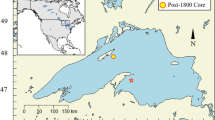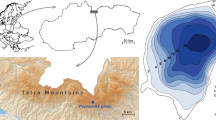Abstract
Banks Island (N.W.T.) has become a focal point for climate change studies in the Canadian Arctic. However, long-term climatic and environmental data are very sparse from this large island, as they are for the entire southwestern region of the Canadian Arctic Archipelago. In this paleolimnological study, diatom species assemblage shifts documented in cores collected from a pond and a lake on Banks Island were interpreted to represent a response to climate warming commencing in the nineteenth century. We found that, although the timing and overall nature of the species changes in the two cores were consistent, the signal was muted in the deeper site likely as a result of differences in ice cover extent and duration between lakes and ponds. A high-resolution study was also conducted from a second pond, at sub-decadal resolution, that only spanned the last ∼60 years. In the deeper lake site, Fragilaria construens and F. pinnata dominated the assemblages, similar to those noted in other high Arctic regions where lakes are characterized by extended ice cover. In contrast, Denticula kuetzingii dominated the shallower ponds and, in the case of the pond core representing the longer time period, this taxon increased in the post-1850 sediments, likely coincident with climate warming. In all cores, diatom assemblages became more diverse and Achnanthes species (particularly A. minutissima) increased from ∼1850 to the present, similar to changes documented in other Arctic regions. Beta diversity values calculated for the diatom species changes indicated that assemblage shifts in the Banks Island cores were of similar magnitude to those recorded in other Arctic regions with high species turnover, such as Ellesmere Island. A diatom-based Total Nitrogen (TN) transfer function previously developed for Banks Island was applied to the three 210Pb dated cores as an exploratory tool for inferring past changes in nitrogen concentrations. In both the lake and pond cores, diatom-inferred TN concentrations tended to increase in the more recent sediments, as may be expected with warming; however these trends were not very distinct.





Similar content being viewed by others
References
Ács E, Kiss KT, Szabó K, Makk J (2000) Short-term colonization sequence of periphyton on glass slides in a large river (River Danube, near Budapest). Algol Stud 100:135–156
ACIA, Impacts of a warming arctic (2004) Arctic climate impact assessment. Cambridge University Press, 146 pp
Antoniades D, Douglas MSV, Smol JP (2005) Quantitative estimates of recent environmental changes in the Canadian High Arctic inferred from diatoms in lake and pond sediments. J Paleolimnol 33:349–360
Appleby PG (2001) Chronostratigraphic techniques in recent sediments. In Last WM, Smol JP (eds) Tracking environmental change using lake sediments. Volume 1: Basin Analysis, Coring, and Chronological Techniques. Kluwer, Dordrecht, The Netherlands, pp 171–203
Babulak JA, Reist JD, Johnson JD, Johnson L (2000) First records of Sockeye (Oncorhynchus nerka) and Pink Salmon (O. gorbuscha) from Banks Island and other records of Pacific salmon in Northwest Territories, Canada. Arctic 53:161–164
Berkes F, Jolly D (2002) Adapting to climate change: Social-ecological resilience in a Canadian Western Arctic community. Conserv Ecol 5:18–33
Birks HJB (1998) Numerical tools in palaeolimnology—progress, potentialities, and problems. J Paleolimnol 20:307–332
Blake W Jr, Boucherle MM, Fredskild B, Janssens JA, Smol JP (1992) The geomorphological setting, glacial history and Holocene development of ‘Kap Inglefield Land’, North-West Greenland. Geoscience Nr. 27, 42 pp
Cumming BF, Wilson SE, Hall RI, Smol JP (1995) Diatoms from British Columbia and their Relationship to Salinity, Nutrients and Other Limnological Variables. Bibliotheca Diatomologica, 207 pp
Doubleday NC, Smol JP (2005) Atlas and classification scheme of arctic combustion particles suitable for paleoenvironmental work. J Paleolimnol 33:393–431
Doubleday NC, Douglas MSV, Smol JP (1995) Paleoenvironmental perspectives on black carbon deposition in the high Arctic. Sci Total Envir 160/161:661–668
Douglas MSV, Smol JP (1993) Freshwater Diatoms from high arctic ponds (Cape Herschel, Ellesmere Island, N.W.T.). Nova Hedwigia 57:511–552
Douglas MSV, Smol JP, Blake W Jr (1994) Marked post-18th century environmental change in high-arctic ecosystems. Science 266:416–419
Douglas MSV, Smol JP (1999) Freshwater diatoms as indicators of environmental change in the High Arctic. In: Stoermer E, Smol JP (eds) The diatoms: applications for the environment and earth sciences. Cambridge University Press, Cambridge, UK, pp 227–244
Ecoclimatic Regions of Canada (1989) Ecological Land Classification Series, No. 23. Environment Canada Ecoregions Working Group, Canada Committee on Ecological Land Classification
Foged N (1974) Freshwater Diatoms in Iceland. Bibliotheca Phycologia 15:1–118
Foged N (1981) Diatoms in Alaska. Bibliotheca Phycologia. Cramer, Vaduz
Germain H (1981) Flore des diatomées. Eaux douces et saumâtres du Massif Armoricain et des contrées voisines d’Europe occidentale. Boubée, Paris, France, 444 pp
Glew JR (1988) A portable extruding device for close interval sectioning of unconsolidated core samples. J Paleolimnol 1:235–239
Glew JR (1991) Miniature gravity corer for recovering short sediment cores. J Paleolimnol 5:285–287
Joynt EH, Wolfe AP (2001) Paleoenvironmental inference models from sediment diatom assemblages in Baffin Island lakes (Nunavut, Canada) and reconstruction of summer water temperature. Can J Aquat Sci 58:1222–1243
Juggins S (2003) C2 User guide – Software for ecological and paleoecological analysis and visualization. University of Newcastle, Newcastle upon Tyne, UK, 69 pp
Keatley BE, Douglas MSV, Smol JP (2006) Early-20th century environmental changes inferred using subfossil diatoms from a small pond on Melville Island, N.W.T., Canadian high Arctic. Hydrobiologia 553:15–26
Kingston JC (1986) Diatom analysis—basic protocol. In: Charles DF, Whitehead DR (eds) Paleoecological investigation of recent lake acidification methods and project description: 6-1–6-11. U.S. Electric Power Research Institute, Palo Alto
Korhola A, Weckström J, Holmstrom L, Erasto P (2000) A quantitative Holocene climatic record from diatoms in northern Fennoscandia. Quat Res 54:284–294
Korhola A, Tikkanen M, Weckström J (2005) Quantification of Holocene lake-level changes in Finnish Lapland using a Cladocera-lake depth transfer model. J Paleolimnol 34:175–190
Krammer K (1992) Pinnularia, eine Monographie der europäischen Taxa. Bibliotheca Diatomologica 26:1–353
Krammer K (2000, 2002) Diatoms of Europe vol 1 & 3. Lange-Bertalot H (ed) A. R. G. Gantner Verlag K. G., Germany
Krammer K, Lange-Bertalot H (1986–1991) Bacillariophyceae. In: Ettl H, Gerloff J, Heynig H, Mollenhauer D (eds), Suβwasserfloa von Mitteleuropa, Band 2(2–4). Gustav Fischer Verlag, Stuttgart/Jena
Krammer K, Lange-Bertalot H (1997) Bacillariophyceae. In: Ettl H, Gerloff J, Heynig H, Mollenhauer D (eds), Suβwasserfloa von Mitteleuropa, Band 2(1). Gustav Fischer Verlag, Stuttgart/Jena
Lange-Bertalot H (ed) (2001) Diatoms of Europe, vol 2. A. R. G. Gantner Verlag K. G., Germany
Lange-Bertalot H, Genkal SI (1999) Diatoms from Siberia I. Annotated diatom monographs, vol 6. Iconographia Diatomologica, Koeltz Scientific Books, Königstein
Lange-Bertalot H, Krammer K (1989) Achnanthes, eine Monographie der Gattung. Bibliotheca Diatomologica 18:1–393
Lange-Bertalot H, Melzeltin D (1996) Annotated diatom monographs, vol 2. Iconographia Diatomologica, Koeltz Scientific Books, Königstein
Lange-Bertalot H, Külbs K, Lauser T, Nörpel-Schempp M, Willmann M (1996) Annotated diatom monographs, vol 3. Iconographia Diatomologica, Koeltz Scientific Books, Königstein
Lim DSS (2004) Limnology and diatom paleoecology of lakes and ponds on Banks Island, N. W. T. and Devon Island, Nunavut, Canadian Arctic. PhD thesis, University of Toronto, Canada
Lim DSS, Douglas MSV, Smol JP (2001) Diatoms and their relationship to environmental variables from lakes and ponds on Bathurst Island, Nunavut, Canadian High Arctic. Hydrobiologia 450:215–230
Lim DSS, Douglas MSV, Smol JP (2005) Limnology of 46 lakes and ponds on Banks Island, N. W. T., Canadian Arctic Archipelago. Hydrobiologia 545:11–32
Lim DSS, Smol JP, Douglas MSV (2007) Diatom assemblages and their relationships to lakewater nitrogen levels and other limnological variables from 36 lakes and ponds on Banks Island, N.W.T., Canadian Arctic. Hydrobiologia 586:191–211
Michelutti N, Douglas MSV, Smol JP (2003) Diatom response to recent climate change in a high arctic lake (Char Lake, Cornwallis Island, Nunavut). Global Planet Change 792:1–15
Michelutti N, Douglas MSV, Wolfe A, Smol J (2006) Heightened sensitivity to late-Holocene climatic changes of a poorly-buffered high arctic lake: A paleolimnological case study. Quat Res 65:421–430
Nichols T, Berkes F, Jolly D, Snow NB (2004) Climate change and sea ice: local observations from the Canadian Western Arctic. Arctic 57:68–79
Pienitz R, Smol JP (1993) Diatom assemblages and their relationship to environmental variables in lakes from the boreal forest-tundra ecotone near Yellowknife, Northwest Territories, Canada. Hydrobiologia 269/270:391–404
Pienitz R, Douglas MSV, Smol JP (2004) Paleolimnological research in polar regions: an introduction. In: Pienitz R, Douglas MSV, Smol JP (eds) Long-term environmental change in Arctic and Antarctic lakes. Springer, Dordrecht, Netherlands, pp 1–18
Reichardt E (1999) Zur Revision der Gattung Gomphonema. Annotated Diatom Monographs, vol 8. Iconographia Diatomologica, Koeltz Scientific Books, Königstein, Germany
Riedlinger D (1999) Climate change and the Inuvialuit of Banks Island, N.W.T.: Using Traditional Environmental Knowledge to complement western science. Arctic 52:430–432
Riedlinger D (2001) Responding to climate change in northern communities: impacts and adaptations. Arctic 54:96–98
Rühland K, Priesnitz A, Smol JP (2003) Paleolimnological evidence from diatoms for recent environmental changes in 50 lakes across Canadian Arctic Treeline. Arctic Antarctic Alpine Res 35:110–123
Rumrich U, Lange-Bertalot H, Rumrich M (2000) Diatoms of the Andes. Annotated diatom monographs, vol 9. Iconographia Diatomologica, Koeltz Scientific Books, Königstein
Ryves DB, McGowan S, Anderson NJ (2002) Development and evaluation of a diatom-conductivity model from lakes in West Greenland. Freshw Biol 47:995–1014
Smith IR (2002) Diatom-based Holocene paleoenvironmental records from continental sites on northeastern Ellesmere Island, High Arctic, Canada. J Paleolimnol 27:9–28
Smol JP (1988) Paleoclimate proxy data from freshwater arctic diatoms. Verhundlungen der Internationalen Vereinigung von Limnologen 23:837–844
Smol JP, Wolfe AP, Birks HJB, Douglas MSV, Jones VJ, Korhola A, Pienitz R, Rühland K, Sorvari S, Antoniades D, Brooks SJ, Fallu M-A, Hughes M, Keatley BE, Laing TE, Michelutti N, Nazarova L, Nyman M, Paterson AM, Perren B, Quinlan R, Rautio M, Saulnier-Talbot E, Siitonen S, Solovieva N, Weckstrom J (2005) Climate-driven regime shifts in the biological communities of arctic lakes. Proc Natl Acad Sci USA 12:4397–4402
Solovieva N, Jones VJ, Nazarova L, Brooks SJ, Birks HJB, Grytnes J, Appleby PG, Kauppila T, Kondratenok B, Renberg I, Ponomarev V (2005) Palaeolimnological evidence for recent climatic change in lakes from the northern Urals, arctic Russia. J Paleolimnol 33:463–482
Stevenson RJ, Peterson CG (1989) Variation in benthic diatom (Bacillariophyceae) immigration with habitat characteristics and cell morphology. J Phycol 25:120–129
ter Braak CJF (1986) Canonical correspondence analysis: a new eigenvector technique for multivariate direct gradient analysis. Ecology 67:1167–1179
ter Braak CJF, Juggins S (1993) Weighted-averaging partial least squares regression (WA-PLS): an improved method for reconstructing environmental variables from species assemblages. Hydrobiologia 269/270:485–502
Weckström J, Korhola A, Blom T (1997) The relationship between diatoms and water temperature in thirty subarctic Fennoscandian lakes. Arctic Alpine Res 29:75–92
Wilson SE, Cumming BF, Smol JP (1996) Assessing the reliability of salinity inference models from diatom assemblages: an examination of a 219-lake data set from western North America. Can J Fish Aquat Sci 53:1580–1594
Wolfe AP (2003) Diatom community responses to late-Holocene climatic variability, Baffin Island, Canada: a comparison of numerical approaches. Holocene 13(1):29–37
Wolfe AP (2002) Climate modulates the acidity of Arctic lakes on millennial time scales. Geology 30:215–218
World Wildlife Fund, Arctic Bulletin: Inuit Observations of Climate Change. No. 1.01:14–15
Acknowledgements
We thank the Natural Sciences and Engineering Research Council (NSERC) for grants awarded to M. Douglas and J. Smol. D. Lim was also supported by the following awards: Ontario Graduate Scholarships (OGS), University of Toronto Graduate Studies Fellowships, and the Northern Scientific Training Programme (NSTP). We are grateful to Fan Yang and Xiaowa Wang (Environment Canada, Burlington, ON) for coordinating the 210Pb dating of core BK-AH1 and the water chemistry analyses of our samples. We also thank the Polar Continental Shelf Project (PCSP) for logistical support while operating in the Canadian Arctic Islands, and D. Antoniades, N. Michelutti, R. Quinlan, K. Rühland, and B. Keatley for both statistical and editorial comments on earlier drafts of this manuscript. This is PCSP/ÉPCP contribution # 016–06.
Author information
Authors and Affiliations
Corresponding author
Rights and permissions
About this article
Cite this article
Lim, D.S.S., Smol, J.P. & Douglas, M.S.V. Recent environmental changes on Banks Island (N.W.T., Canadian Arctic) quantified using fossil diatom assemblages. J Paleolimnol 40, 385–398 (2008). https://doi.org/10.1007/s10933-007-9168-0
Received:
Accepted:
Published:
Issue Date:
DOI: https://doi.org/10.1007/s10933-007-9168-0




